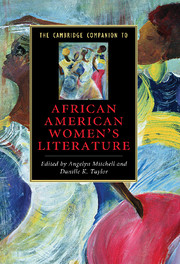Book contents
- Frontmatter
- Introduction
- Part 1 History, contexts, and criticism
- 1 Early African American women’s literature
- 2 Women of the Harlem Renaissance
- 3 Women writers of the Black Arts movement
- 4 Contemporary African American women writers
- 5 African American feminist theories and literary criticism
- Part II Genre, gender, and race
- Bibliography
- Index
2 - Women of the Harlem Renaissance
from Part 1 - History, contexts, and criticism
Published online by Cambridge University Press: 28 July 2009
- Frontmatter
- Introduction
- Part 1 History, contexts, and criticism
- 1 Early African American women’s literature
- 2 Women of the Harlem Renaissance
- 3 Women writers of the Black Arts movement
- 4 Contemporary African American women writers
- 5 African American feminist theories and literary criticism
- Part II Genre, gender, and race
- Bibliography
- Index
Summary
Joanna Marshall, the protagonist of Jessie Fauset's There Is Confusion (1924), one of the first novels of the Harlem Renaissance, insists “that if there's anything that will break down prejudice it will be equality or perhaps even superiority on the part of colored people in the arts.” Fauset shared this belief with other leaders of the New Negro movement, Alain Locke, Charles Johnson, and James Weldon Johnson. The time seemed ripe. During the 1920s almost every Broadway season saw the opening of a production featuring black entertainers, beginning in 1921 with Shuffle Along, which introduced Josephine Baker to the theatrical world. Traditional African American dances like the Charleston were featured in Broadway musicals and quickly became national fads. European painters and sculptors drew inspiration from African art. Negro spirituals were made a permanent part of the concert repertoire on the initiative of singers Roland Hayes, Paul Robeson, and Marian Anderson. Through the magic of the newly invented radio and through phonograph recordings, black secular music reached white America. The decade marked the heyday of the classic blues singers whose art reached its pinnacle in the work of Bessie Smith, the so-called Empress of the Blues. The most popular music of the decade was jazz, a music created by blacks that white America enjoyed so much the decade was dubbed the Jazz Age. The vogue for African and African American art seemed to portend greater support for black peoples' political rights. It did not. But it did open a space for writers, who were able to make art of both the expanded opportunities and the persistent constraints.
- Type
- Chapter
- Information
- Publisher: Cambridge University PressPrint publication year: 2009
- 1
- Cited by



